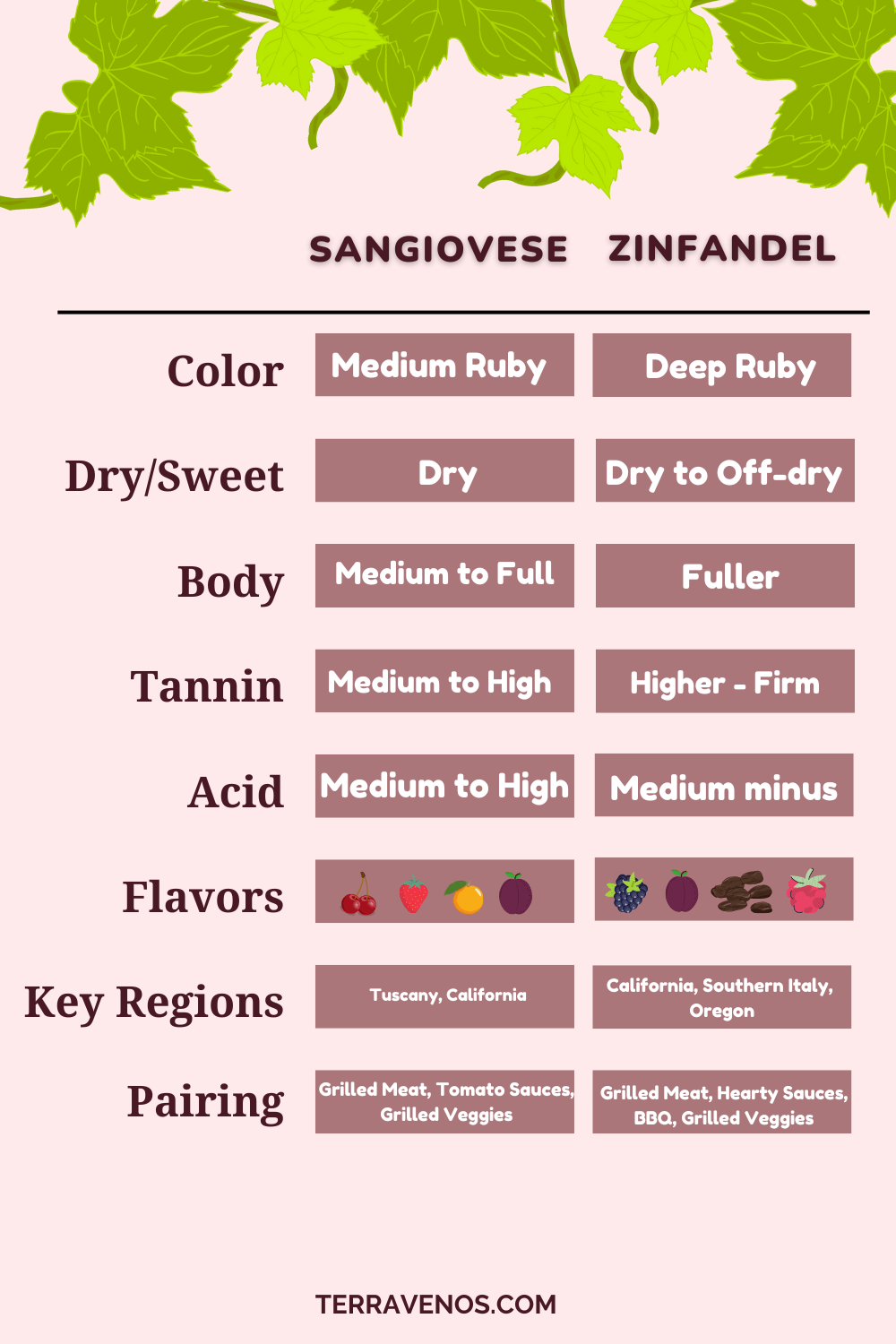
When it comes to red wines, two popular contenders that stand out are Sangiovese and Zinfandel.
Italy’s Sangiovese exhibits a medium body, pronounced acidity, high tannins, and a combination of crunchy cherry and herbal notes. Zinfandel has a fuller body with softer tannins, offering red berries and warm spice. You’ll find both wines for $15-$50 USD, but Sangiovese can produce affordable bulk wines suitable for everyday enjoyment.
Here’s what you need to know about the differences between Sangiovese and Zinfandel.
- Sangiovese Basics: The Everyday Italian
- Zinfandel Basics: A Californian Darling
- Wine Comparison: Sangiovese vs. Zinfandel
- Sangiovese vs. Zinfandel Winemaking
- Sangiovese vs. Zinfandel: Food Pairings and Serving Temperature
- Which Is More Expensive, Sangiovese vs. Zinfandel?
- Final Thoughts – Sangiovese or Zinfandel?
Sangiovese Basics: The Everyday Italian
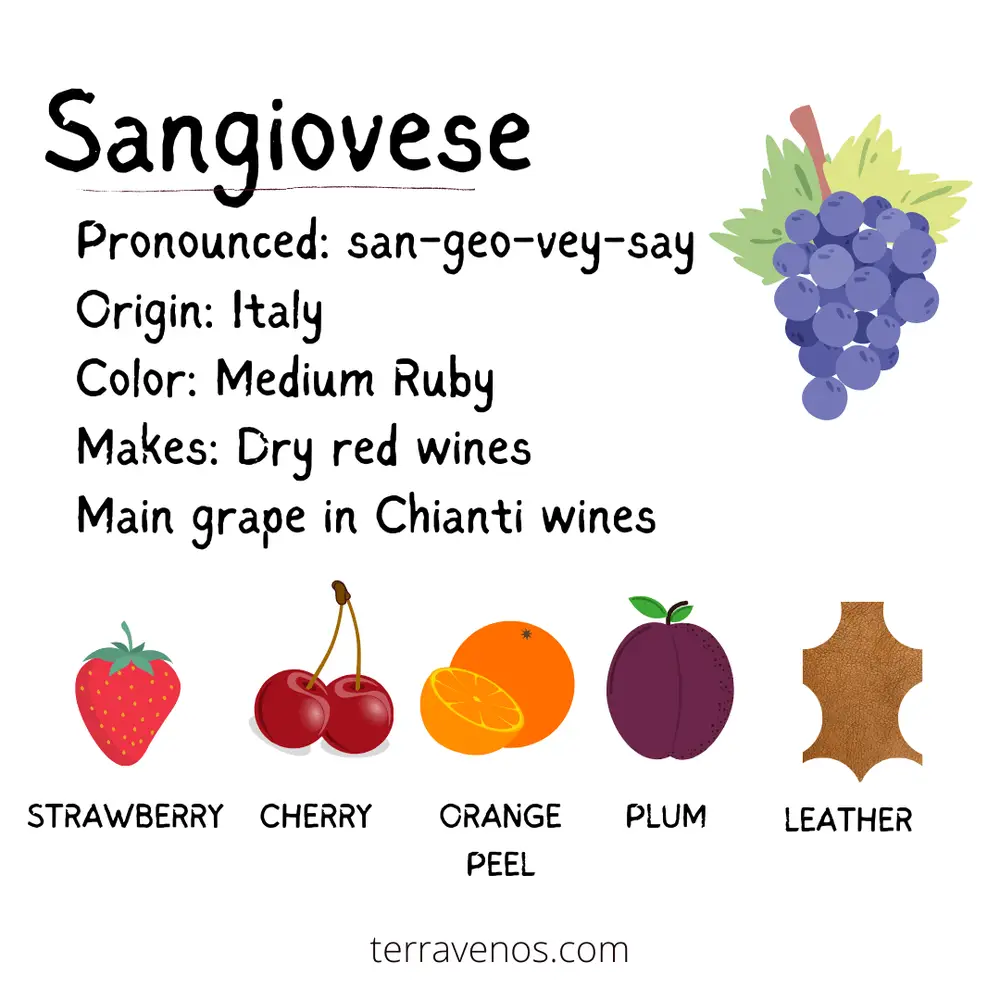
Sangiovese, an ancient Italian grape, has a prominent role in the country’s wine culture. Mainly cultivated throughout Italy, it has a reputation for being a workhorse grape. It crafts higher-acid wines with a medium body and fresh red fruit notes, such as cherries and raspberries, complemented by subtle herbal undertones and a touch of earthiness. Italy is the world’s primary producer of Sangiovese, offering a diverse range of options catering to various tastes and budgets, from everyday drinking wines to premium selections. You’ll also find Sangiovese in California.
Fun Wine Fact: Sangiovese takes center stage in the world-renowned Chianti wine. Don’t miss this post on how to buy Chianti wines, complete with a handy print-out shopping guide. And here’s a full post on just Sangiovese if you’re curious about winegrowing regions and winemaking.
Zinfandel Basics: A Californian Darling
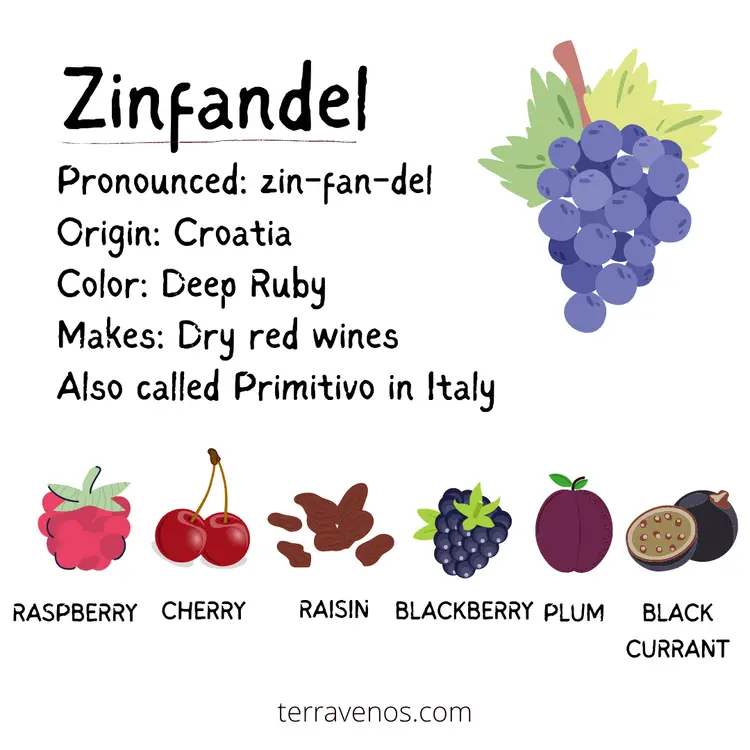
Zinfandel, originally known as Primitivo, has historical roots in Croatia and Italy, but it has become California’s signature wine grape. This grape variety exhibits a fuller body and luscious profile, boasting abundant red berry aromas that often reveal notes of raspberry, blackberry, and a hint of warm spices like cinnamon.
While California remains the primary region associated with Zinfandel, this versatile grape has also thrived in other areas such as Oregon and various parts of the world.
For more in-depth information about Zinfandel, check out this full post on Zinfandel.
Wine Comparison: Sangiovese vs. Zinfandel
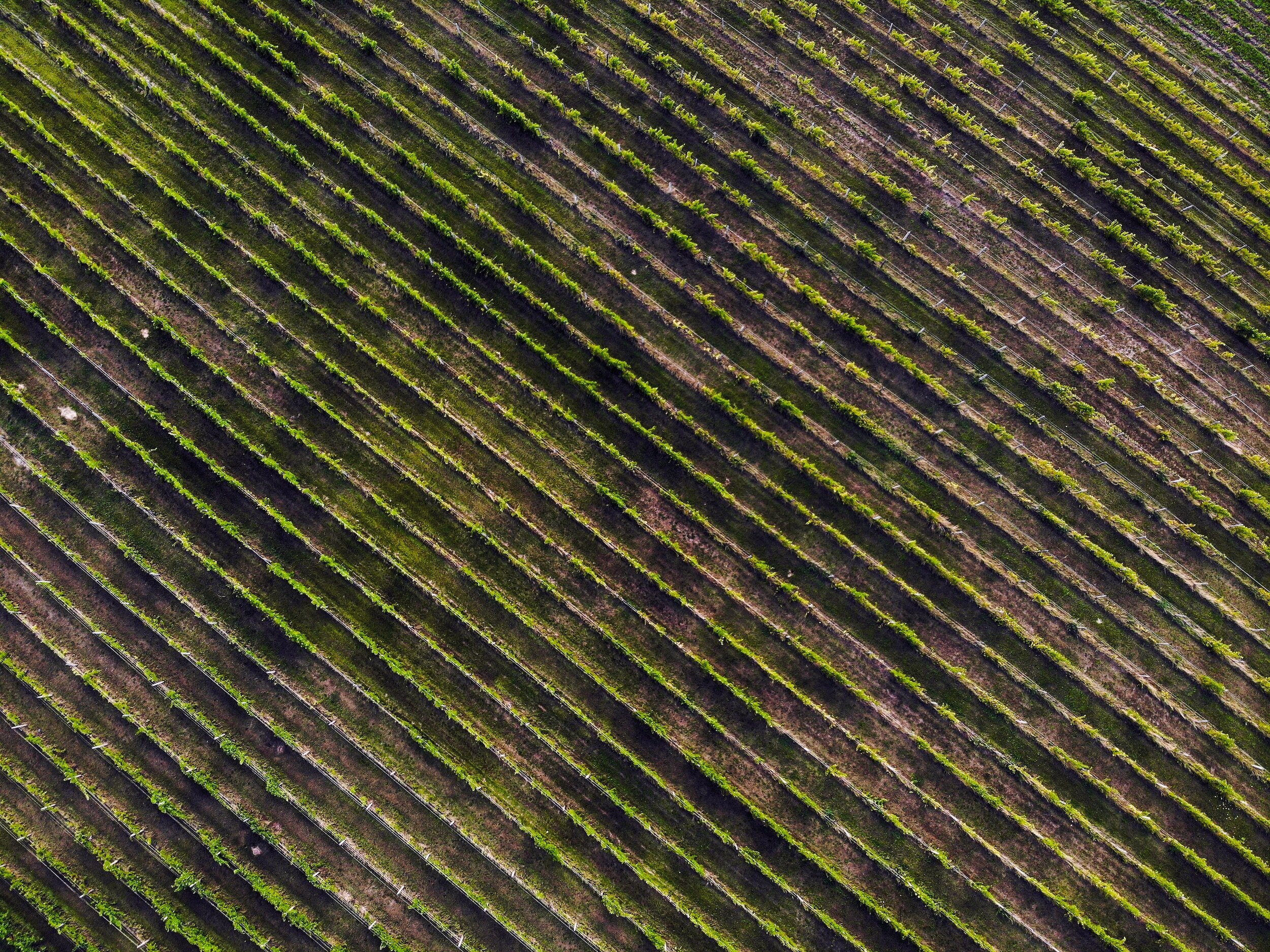
Let’s delve into a side-by-side comparison of Sangiovese and Zinfandel.
Sangiovese Wine Profile:
- Sweetness: Typically produced in a dry style, Sangiovese offers minimal residual sugar.
- Alcohol: Sangiovese wines generally have a moderate alcohol content, ranging from around 13% to 14.5% ABV.
- Body: Sangiovese has a medium body, and you may come across fuller expressions in premium selections.
- Acid: Medium plus acidity adds brightness and freshness to the red fruit taste.
- Tannin: Medium, and textured. Cooler years can introduce herbal notes to the wine.
- Flavor and Aroma Intensity: Sangiovese boasts red cherries, raspberries, and hints of herbs and earthiness.
- Flavors: The flavor profile often includes notes of red berries, a little orange peel, subtle spice, and herbal undertones.
Zinfandel Wine Profile:
- Sweetness: Zinfandel leans towards dryness, presenting a range of dry to off-dry styles.
- Alcohol: Zinfandel wines typically have higher alcohol, especially when grown in hotter regions, often in the 13%+ (I’ve seen Zins in the 16% range, which is very high) – this is one reason why they can be off-dry.
- Body: Zinfandel is known for its fuller body, offering a lush and rich mouthfeel.
- Acid: Zinfandel has lower acid than Sangiovese, usually in the medium-minus range
- Tannin: Zinfandel medium to medium plus tannins that are chewy.
- Flavor and Aroma Intensity: Zinfandel exhibits enticing berry aromas, such as raspberry and blackberry, raisin notes, plum, and warm spice.
- Flavors: The flavor profile often includes rich, jammy fruit notes complemented by a touch of cinnamon or other warm spices.
Are Sangiovese and Zinfandel Similar?
Both Sangiovese and Zinfandel are structured red wines, meaning that you’ll notice their tannin, alcohol, and acid levels. You’ll want to drink these wines with food, not as solo sippers.
Helpful Tip: Looking for lighter red wines? Then head over to this post for a list of amazing light red wines worthy of your time.
What Is the Difference Between Sangiovese and Zinfandel?
Sangiovese tends to have a medium body and herbal undertones, while Zinfandel boasts a fuller body with luscious jammy berry flavors and warm spice notes. Sangiovese wines will have higher acid, making their fruit taste fresh and crunchy. Zinfandel has lower acid, often with jammy ripe fruit flavors. Zinfandel also tends to have slightly higher alcohol content compared to Sangiovese, although this may vary depending on the growing region.
Sangiovese vs. Zinfandel Winemaking
Winemakers use different techniques when crafting Sangiovese and Zinfandel. This includes the use of neutral vessels like stainless steel or barrels for fermentation and aging. The price-point for each wine often influences the winemaker’s approach. Inexpensive, bulk Sangiovese may be fruit-forward with little to no oak influence, while more premium offerings may see more extensive oak aging.
Both wines undergo traditional red winemaking processes.
Sangiovese vs. Zinfandel: Food Pairings and Serving Temperature
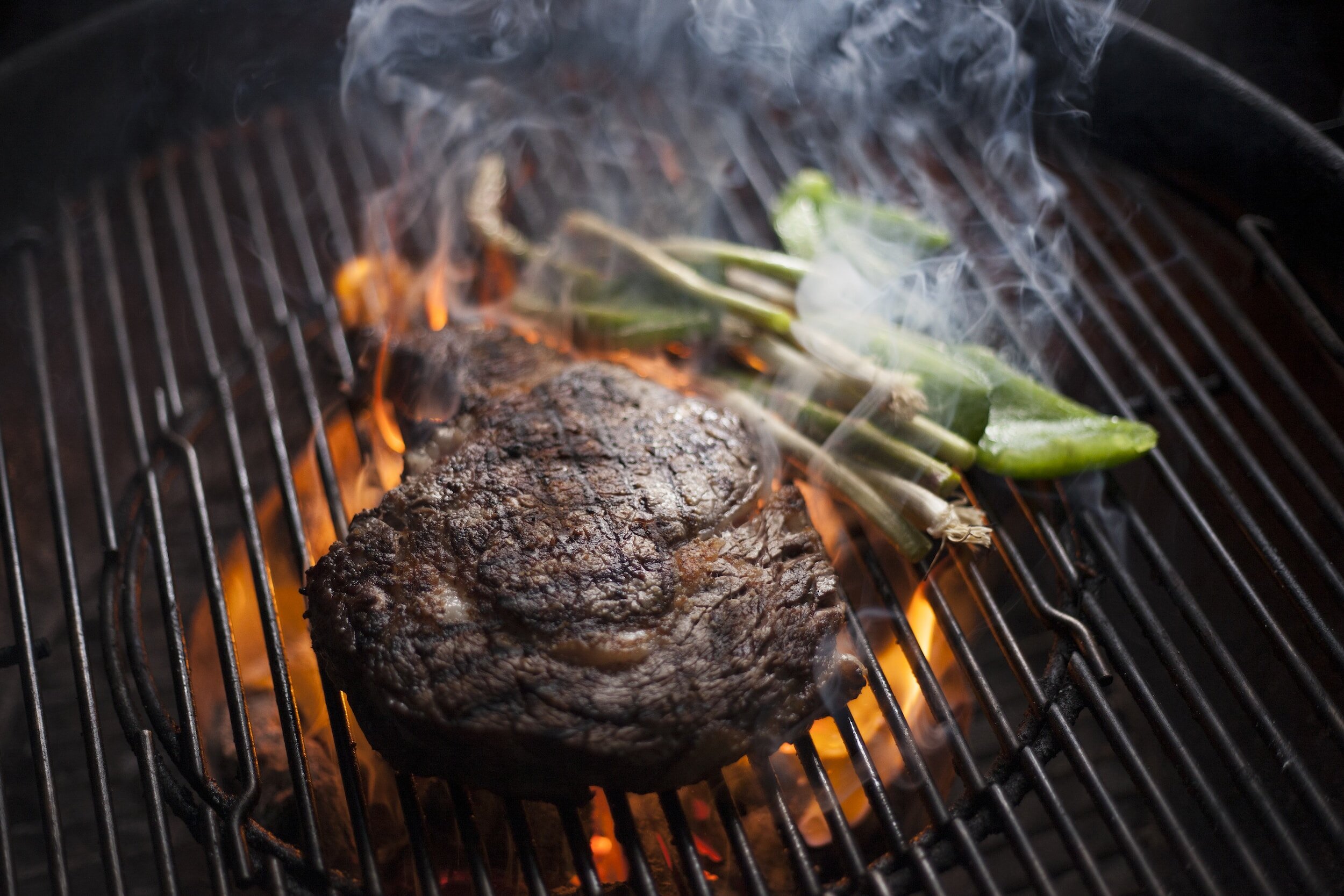
- Sangiovese’s medium body and higher acidity make it a wonderful match for classic Italian dishes, including pasta with tomato-based sauces, grilled meats, and aged cheeses. Check out this full Sangiovese pairing guide for everyday people.
- Zinfandel’s fuller profile and rich red fruit flavors make it an excellent companion for dishes like barbecued meats, hearty stews, and roasted vegetables.
Helpful Tip: Still figuring out the mystery of food and wine pairing? Check out this quick guide.
Serving Sangiovese and Zinfandel Comparison
| Aspect | Sangiovese | Zinfandel |
|---|---|---|
| Serving Temp | 60-65°F | 60-65°F |
| Decanting Recommendations | Not necessary, but improves with aeration | 30 minutes to 1 hour to enhance flavors |
| Glass Shape | Tulip-shaped | Bordeaux or Burgundy glass |
Both Sangiovese and Zinfandel are best served slightly chilled. Place them in the refrigerator for approximately 15-20 minutes before serving to reach the ideal temperature. While most Sangiovese wines can be enjoyed immediately after opening (decant fuller styles and aged bottles), Zinfandel benefits from some aeration before tasting.
Helpful Wine Drinking Tip: Inexpensive, entry-level wines rarely benefit from decanting. Give them a good swirl in your glass to open them up and then sip away!
Which Is More Expensive, Sangiovese vs. Zinfandel?
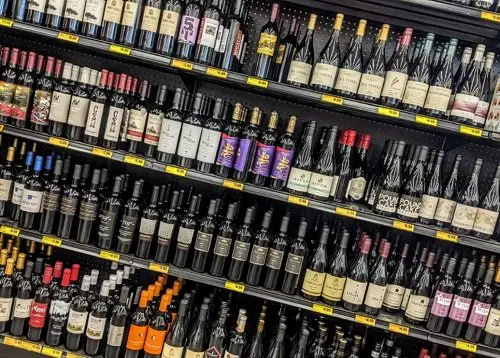
The price of a wine bottle depends on various factors, but tend to be similarly priced for the different quality levels. Note: This may vary depending on where you live and what’s closer to home.
Sangiovese Wine Price
- Entry-level Sangiovese: Under $10 USD
- Premium Sangiovese: $15-$25 USD
- Super-Premium Sangiovese: $30-$50 USD
Zinfandel Wine Price
- Everyday Zinfandel: $8-$15 USD
- Premium Zinfandel: $20-$30 USD
- Super-Premium Zinfandel: $50+ USD
Helpful Tip: Here’s a full breakdown of how a wine bottle gets priced if you’re curious about that sort of thing.
Which Is Better, Sangiovese or Zinfandel?
If you enjoy red wines with a medium body, vibrant acidity, and chewy tannins, then Sangiovese is the right pick for you. If you prefer wines with a fuller body, and jammy flavors with warm spice notes, then Zinfandel should be your choice.
Final Thoughts – Sangiovese or Zinfandel?
Both Sangiovese and Zinfandel have their unique charm and characteristics. One of the best ways to appreciate their differences is to host a side-by-side tasting. Invite your friends and savor an evening of exploration, allowing each bottle to tell its own unique story. This experiment is definitely worth repeating!
Discover:
Sangiovese vs Cabernet Sauvignon
Sangiovese vs Merlot
Sangiovese vs Pinot Noir
Sangiovese vs Chianti
Sangiovese vs Syrah
Thirsty for More?
If you’re enthusiastic about expanding your wine knowledge, why not consider hosting your own wine tasting for beginners?
Explore other wine comparisons, such as Malbec and Cabernet Franc, and Cabernet Sauvignon vs. Cabernet Franc.
Remember that delicious wines can be found at every price point, so here’s how to find great wines under $50.



